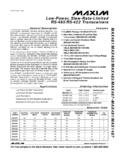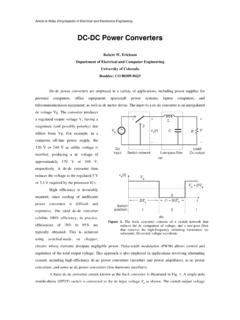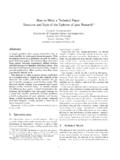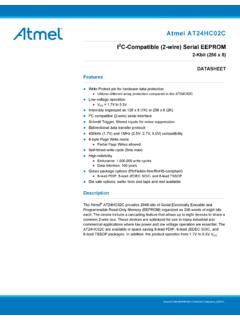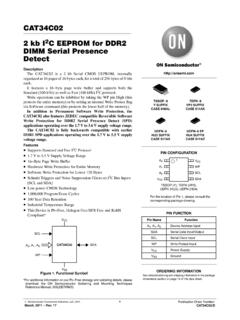Transcription of Basic Serial EEPROM Operation
1 1993 Microchip Technology 18 Basic Serial EEPROM OperationBASIC Serial EEPROM OPERATIONL ooking for the optimum non-volatile memory productfor your system that requires a small footprint, byte levelflexibility, low power, and is highly cost effective? SerialEEPROM technology is one of the non-volatile memorytechnologies that has emerged as a leading embeddedcontrol solution. Unfortunately, most system designersare not aware of the Serial EEPROM benefits. Also, thesupporting documentation in databooks is most oftennot adequate due to incomplete or ambiguous informa-tion. As a result, the system designer often selects anon-volatile solution that does not meet his require-ments, or, the designer must face a more complicateddesign-in with a Serial article addresses two issues that exist today fordesigners considering Serial EEPROM products:First, to provide awareness of the application , to provide a primer on the operating prin-ciples and instructions.
2 These items are often buried indatabook text or not adequately addressed. Also in-cluded are common default conditions to significantlyreduce the system designer s learning EEPROM ApplicationsOverview of the Primary Protocol Benefits3- wire Bus Operation Primer2- wire Bus Operation PrimerMicrochip 2- wire Default ConditionsTiming Diagram AttachmentsSERIAL EEPROM APPLICATIONSS erial EEPROMS are ideal non-volatile cost effectivememory solutions in applications that require: Small footprint and board space as in cellular phoneapplications BYTE level ERASE, WRITE, and READ of data as ina TV tuner Low voltage and current for handheld battery applica-tions as in a keyless entry transmitter Multiple non-volatile functions in the same applicationsuch as a VCR Low availability of microcontroller I/O linesThe common applications for Serial EEPROMS areshown below:MarketCommon ApplicationsConsumerTV tuners, VCRs, CD players, cam-eras, radios, and remote controlsAutomotiveAirbags, anti-lock brakes, odom-eters, radios, and keyless entryOffice Automation Printers, copiers, PCs, and portablePCsTelecomCellular, cordless and full featurephones, faxes, modems, pagers,and satellite receiversIndustrialBar code readers, point-of-sale ter-minals, smart cards, lock boxes,garage door openers, and test mea-surement equipmentThe typical functions that Serial EEPROMs are utilizedfor are: Memory storage of channel selectors or analog con-trols (volume, tone, etc.)
3 In consumer electronicsproducts Power down storage and retrieval of events such asfault detection or error diagnostics in automotive prod-ucts Electronic real time event or maintenance logs suchas page counting in office automation products. Also,configuration or DIP switch storage in office automa-tion products Last number redial storage and speed dial numberstorage in telecom products User in-circuit reprogrammable look up tables such asbar code readers, point-of-sale terminals, environ-mental controls and other industrial productsOther application examples include: Data storage from a learn function as in a remotecontrol transmitter ID number storage for security or remote access forelectronic keys and entry databases Reprogrammable calibration data for test equipmentor analog interface productsAN536 Basic Serial EEPROM Operation8-1DS00536C-page 2 1993 Microchip Technology Serial EEPROM OperationAs a result of density and architectural evolution, SerialEEPROMs offer significant benefits in some applica-tions that previously could only utilize Parallel EEPROM products.
4 The diagram below illustrates the footprint andboard space Serial vs 16K Parallel BenefitsThe Serial EEPROM requires only 10% of the boardspace that a Parallel EEPROM requires. Also, the SerialEEPROM requires fewer I/O lines from the microcon-troller which significantly reduces the overall systemcost and board very fast READ speed is the only significant limitationof a Serial EEPROM for a decision between a Serial anda Parallel EEPROM . It is very interesting to note that theSerial EEPROM READ speed is restricted more by theprotocol than the process technology. The 2- wire I2C(Inter-Integrated Circuit) products must add large inter-nal delays to slow down the part to meet the 100 KHzprotocol requirements, which will be reviewed of 3- wire bus Serial EEPROMs haveindicated clock frequencies in excess of OF THE PRIMARYPROTOCOL BENEFITSA fter a designer decides to use a Serial EEPROM solution, the next step is to select one of the two primaryserial EEPROM protocols.
5 Unfortunately, most systemdesigners select the type of Serial EEPROM (2- or 3- wire ) that they are most familiar with, regardless of thebenefits associated with each 'S REQIDD (ma)BOARD SPACE (sq in)uCont & NVM COST ($)16k PARALLEL EE16K Serial EE 1993 Microchip Technology 38 Basic Serial EEPROM OperationThe benefits of each protocol are shown below:3- wire Bus Serial EEPROMS2- wire Bus Serial EEPROMSS ingle VDD supply of <2V to VDD supply of <2V to low current consumptionVery low current consumptionReduced overall component costReduced overall component costFour pins (other than VCC & GND) are requiredTwo pins (other than VCC & GND) are required for operationor operationx16 bit and x8 bit data widthsx8 data bit widthSoftware WRITE ProtectionHardware WRITE ProtectionEdge triggered clocks and signalsLevel triggered clocks and signals and input glitch filters forhigh noise immunity2 MHz+ operationI2C standard 100 KHz and 400 KHz protocols with a 1 MHzoptionReady/Busy data pollingPage WRITE capability to 16 bytesSecurity options availableSoftware and hardware compatible from 2K to 16K densitiesLess complex protocolA 2- wire product is utilized in applications that require anI2C bus, noise immunity, limited microcontroller I/O pinavailability, or a WRITE buffer for multiple bytes to bestored with one instruction.
6 A 3- wire product is utilized inapplications that have limited protocol requirements, anSPI protocol, higher clock frequency requirements, orx16 data width next two sections describe the Basic Operation andMicrochip s default conditions for the 3- wire and 2-wireSerial EEPROMs to allow the system designer to utilizethe benefits of Serial BUS Operation PRIMERMany Serial EEPROM data sheets are written in aconventional memory data sheet format which empha-sizes the features of the part more than the basicoperating principles. The operating principles are unfor-tunately either vaguely embedded in the data sheet textor not included. Serial EEPROMs are not conventionalmemories due to the Serial communication protocolsinvolved. This section is a PRIMER for the data sheet tofamiliarize the system designer with the Basic principlesof the 3- wire bus PrinciplesCommon device nomenclature is 93XX06 is a 256 bit 93XX46 is a 1K bit 93XX56 is a 2K bit 93XX66 is a 4K bit pins are required:CS (Chip Select)DI (data in)CLK (Clock)DO (data out)All 93 XXXX parts are hardware compatible for thesefour pins.
7 However, there may be compatibility issues forthe other though there is hardware compatibility on the fourpins, there can be differences from a software stand-point. Subtle differences between each manufacturer sproducts, referred to as default conditions, can preventplug compatibility. These issues are addressed later inthe attached 3- wire Timing Diagram. There is no indus-try standardized upgrade path for density review density upgrades for Microchip s prod-ucts on a case-by-case is available in x8 or x16 organizations. This selec-tion is determined either by the ORG pin or by purchas-ing a standard x16 will power-up in a EWDS (ERASE/WRITE DisableState). All ERASE and WRITE functions are disableduntil the EWEN (ERASE/WRITE Enable) instruction isperformed. This is to prevent accidental data Auto-ERASE (logical 1 ) cycle is performed duringeach WRITE 7 instructions are shown in the attached instructionset table.
8 These instructions are for Microchip s 93 LCXX family an instruction is loaded, the CLK and DI pins are ina DON T CARE state until the next START 4 1993 Microchip Technology Serial EEPROM OperationThe following is required for each instruction set (allinput bits are triggered by the positive clock edges):Start BitThe first Data-in high signal clocked inafter CS is Bits to identify the instructionAddressRefer to the Instruction Set table for thenumber of bits data-in and data-out pins. How-ever, these two pins may be tied togetherfor true 3- wire Operation . Please refer tothe attached 3- wire Bus READ timingdiagram , WRITE, and ERASEThe attached 93LC66 timing diagrams illustrate the keyconcepts and timing parameters for each of these op-erations. Please refer to the instruction set tables andthe AC parameters in the databook for ALL (ERAL)An ERASE ALL (ERAL) Operation is identified by a 00 opcode.
9 The ERAL instruction requires the next two bitsto be clocked in as 10 in the address block of theinstruction set. All bits in the array will be set to a logic 1 state by one command in typically less than ALL (WRAL)A WRITE ALL (WRAL) Operation is also identified by a 00 opcode. The WRAL requires the next two bits to beclocked in as 01 in the address block of the instructionset. The data-in block will contain the data for a SINGLEBYTE which is to be repeated throughout the entirearray. For example, if a 4F5A is loaded in the 16 data-inbits of the instruction set, a 4F5A will be written into everyword in the and EWDSAs stated before, all units will power up in to an ERASE/WRITE DISABLE (EWDS) state to prevent data corrup-tion. All future ERASE/WRITE operations must executean ERASE/WRITE ENABLE (EWEN) opcode until thenext power down is detected or until other EWDS opcodes are executed.
10 Please refer to the instruction 1993 Microchip Technology 58 Basic Serial EEPROM OperationInstructionSBOpcodeAddressData InData OutReq. CLK CyclesREAD110X A6 A5 A4 A3 A2 A1 A0 D15 - D027 EWEN1001 1 X X X X X X High-Z11 ERASE111X A6 A5 A4 A3 A2 A1 A0 (RDY/BSY)11 ERAL1001 0 X X X X X X (RDY/BSY)11 WRITE101X A6 A5 A4 A3 A2 A1 A0D15 - D0(RDY/BSY)27 WRAL1000 1 X X X X X XD15 - D0(RDY/BSY)27 EWDS1000 0 X X X X X X High-Z11 InstructionSBOpcodeAddressData InData OutReq. CLK CyclesREAD110A6 A5 A4 A3 A2 A1 A0 D7 - D018 EWEN1001 1 X X X X X High-Z10 ERASE111A6 A5 A4 A3 A2 A1 A0 (RDY/BSY)10 ERAL1001 0 X X X X X (RDY/BSY)10 WRITE101A6 A5 A4 A3 A2 A1 A0D7 - D0(RDY/BSY)18 WRAL1000 1 X X X X XD7 - D0(RDY/BSY)18 EWDS1000 0 X X X X X High-Z10 InstructionSBOpcodeAddressData InData OutReq. CLK CyclesREAD110A5 A4 A3 A2 A1 A0 D15 - D025 EWEN1001 1 X X X X High-Z9 ERASE111A5 A4 A3 A2 A1 A0 (RDY/BSY)9 ERAL1001 0 X X X X (RDY/BSY)9 WRITE101A5 A4 A3 A2 A1 A0D15 - D0(RDY/BSY)25 WRAL1000 1 X X X XD15 - D0(RDY/BSY)25 EWDS1000 0 X X X X High-Z9 INSTRUCTION SET FOR 93LC56: ORG = 1 (x 16 organization)INSTRUCTION SET FOR 93LC46: ORG = 0 (x 8 organization)INSTRUCTION SET FOR 93LC46: ORG = 1 (x 16 organization)InstructionSBOpcodeAddressD ata InData OutReq.

